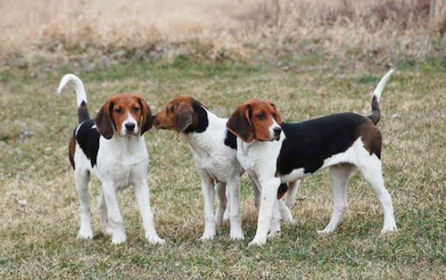
Treeing Walker Coonhounds got their descriptive moniker, “treeing coonhound” because they were faster than English hounds at chasing down prey and trapping it in a tree. It’s written by some sources that approximately half of all purebred coonhounds in the United States are Treeing Walkers, the other half divided between the remaining five or six breeds.
With regards to their coloring, most “Walkers” have brown and black bodies with white legs, a white chest and white stomach, the ears and head brown or black, and many with a white blaze on their forehead. Very few treeing Walkers are almost entirely white, though it’s said that the Clover bloodline* has a few. When the dog has black marking over his back that extends from the neck to the tail, it’s called a “blanket back” or “saddle back pattern,” a coloring that is highly prized by some fanciers. Coonhounds that are mostly brown legged and have a black saddleback with almost no white are known as “high tans,” but it’s not a common coloring.
*The Clover line of dogs was started by Lee Logan of Pennsylvania who picked a dog he named “Clover” out of a litter because of the perfect clover shaped marking on his side.
Image from AKC website and shared with consent

In scent hounds saddle saddleback and Blanket-back are distinct and separate marking of traditionally tri color marks. As with much of dog nomenclator is comes down for horses. In Blanket/blanket-back the Black covers the dog’s back neck to tail and come down the sides rib, loins & Flank substantially similar to a Horse wearing a blanket, In saddle/saddleback coloration the black area is much smaller, does not extend from neck to back d usually does not extend down the sides as much as well. The Black area resembles the area that would be covered by a saddle on a horse. As the saddle area becomes larger, it starts to more and more resemble a blanket. Exactly where Saddle ends and Blanket begins is in the eye of the beholder.